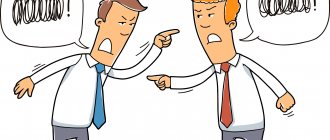In psychology there is such a term as deviation. It characterizes the deviating behavior of people living in society. Deviant actions, from a moral and legal point of view, are unacceptable. However, due to various reasons, goals and life circumstances, people act contrary to the norms acceptable in society.
What is deviant behavior
Under deviant behavior
It is common to understand actions that contradict established social norms.
The persistent manifestation of deviations forces society to apply sanctions to this person - isolation, punishment, correction, treatment.
Simply put, deviation is a violation of any rules. In this regard, psychologists claim that the vast majority of people on the planet are deviants. Indeed, it is difficult to live your whole life without violating a single established rule - this means not only state legislation, but also some informal regulations, such as the need to communicate with friends in your free time. Too much work ethic (“workaholism”) and a passion for dieting are also deviations.
Diagnostics
If there are suspicions that a child is increasingly showing himself as deviant, he needs to be shown to a psychologist. He carries out primary diagnostics using questionnaires and tests. The most common of them:
- method of express diagnostics of intellectual abilities;
- methodology for diagnosing socio-psychological adaptation (Rogers and Diamond);
- for younger schoolchildren - projective techniques;
- technique for identifying frustration (Rosenzweig);
- method for determining the level of school anxiety (Phillips);
- Manipulative Attitude Scale (Banta);
- aggressiveness test (Bassa-Darki)
- Internet addiction test (Nikitina, Egorov)
- Schulte tables;
- Luscher technique;
- Wechsler scale;
- test for self-assessment of mental states (Eysenck);
- Stott sighting map.
There are a huge number of diagnostic methods. Experts select them in accordance with each specific situation.
Signs of deviant behavior
There are clear signs that an individual’s actions are deviant behavior, namely
:
- Inconsistency with generally accepted social norms;
- Violation of these norms;
- Negative assessment of others, imposition of sanctions;
- Causing harm to yourself and others;
- Persistence – the antisocial act is repeated many times;
- Social maladjustment;
- The general orientation of the personality is destructive.
The last feature, however, is controversial. After all, the concept of deviant behavior also includes cases such as talent, genius, heroism and self-sacrifice. Such actions and manifestations also violate some established rules, but ultimately their goal is the creation, sometimes even the salvation of society.
Basic Concepts
In simple words, deviant behavior is persistent (constantly repeated) behavior that deviates from generally accepted social norms. There is another concept for this phenomenon - social deviation. Society is forced to respond to it with certain sanctions: isolation, treatment, correction, punishment.
Since deviant behavior is the subject of study of various sciences, each of them gives it its own specific definition.
Sociology
Sociologists call deviant behavior any social phenomenon that poses a threat to human life, caused by a violation of the process of assimilation of norms and values, self-development and self-realization in society.
Medicine
For doctors, deviance is a borderline neuropsychic pathology that leads to deviation from generally accepted norms of interpersonal interactions. At the same time, doctors recognize that not all cases are the result of personality and behavioral disorders. Mentally healthy people often demonstrate deviant behavior.
Psychology
In psychology, this is a deviation from social and moral norms, an erroneous conflict resolution pattern directed against society. It can be measured quantitatively (which determines the degree of neglect of the problem) - through the damage caused to public well-being, others or oneself.
Based on these definitions, it is not difficult to understand who a deviant is. This is a person who demonstrates traits of deviant, unacceptable behavior and needs the help of specialists: psychologists, psychotherapists, neurologists.
The psychology of deviant behavior is a scientific discipline that studies the essence, causes and manifestations of persistent inappropriate behavior. Various specialists work in this area - clinical and developmental psychologists, teachers, lawyers and sociologists. Currently, special attention is paid to methods of prevention and correction of deviations in adolescence and youth.
Deviantology is a science that studies deviations and society's reaction to them. It includes work in this direction, carried out by various sciences: psychology, psychotherapy, criminology, sociology.
Types of deviant behavior
Psychology, sociology and medicine have their own approaches to defining deviant behavior and classify its types in different ways. Different scientific directions even define actions and actions differently - one school considers some action “normal”, while another considers it deviant.
One of the existing classifications of deviant behavior was proposed by Ts.P. Korolenko and T.A. Donskikh - domestic psychiatrists.
- Non-standard behavior
- in this case, the individual violates some rules, but in general his activities are positive and useful for society. - Destructive behavior
– has a destructive orientation. In this case, externally destructive and internally destructive actions are distinguished. In the first case, a person either uses certain means to escape reality and get the desired emotions (alcoholism, drug addiction, gambling, etc.), or directly violates laws and causes harm to others.
In the second case, a person’s actions are aimed at direct self-destruction - suicide, fanaticism, conformism, narcissism, etc.
Human behavior itself is a reaction to social norms. There can only be a few such reactions, and their description was given at one time by Robert King Merton, one of the greatest sociologists of the twentieth century.
Each society forms both the goals of its existence and the means of achieving them, and each individual responds to this through one of the possible reactions
:
- Submission - complete submission to both goals and means of achieving them;
- Innovation - the individual submits to the goals of society, but uses other means to achieve them;
- Ritualism - the goal is rejected as unattainable, but a “mechanical” adherence to traditions remains;
- Retreatism is withdrawal from society due to disagreement with its goals and means;
- Rebellion is an attempt to bring a new order to society, to change both goals and means.
Three of these types of behavior are outright deviant. But ritual behavior in most cases is not perceived as deviant: society, as a rule, pays attention only to the external side of the behavior of individual people. It is believed that almost all members of society practice ritual behavior without thinking about the purposes of existence or even outright denying them.
How to recognize a deviant
To better understand what deviant behavior is, you need to familiarize yourself with its manifestations or symptoms, which will tell you that this is a deviant. Even if you don’t know a person well, you just met him recently, deviations will be visible even in small things.
For example, with delinquent behavior, the individual has little idea of what laws, norms and rules are. In a comic form, he can steal chewing gum at the checkout of a hypermarket, get angry at a person who accidentally stepped on his foot, and verbally demonstrate disagreement and rebellion.
Addictive behavior is often accompanied by delinquent behavior, but can also exist independently. Such people are very vulnerable, do not tolerate loneliness well and are easily influenced. In this case, an example of deviant behavior is street groups of teenagers who use drugs and engage in robbery.
Signs of psychopathological manifestations are delusional thoughts, hallucinations, idefix, illusory perception of reality. And the destructive form of deviations is manifested by various types of aggression, directed both inward and outward.
All manifestations can be identified in a separate list:
- problem in adaptation, frequent conflicts, belonging to “bad” companies”;
- scattered attention, leaving things halfway, lack of responsibility;
- infantilism, untidiness in clothing and household activities;
- mental disorders in the form of phobias, anxieties and other neurotic manifestations;
- Typical manifestations of deviant behavior are also low self-esteem and lack of self-confidence;
- poor health, pain, psychosomatic symptoms, sleep problems;
- isolating oneself from society, frequently leaving home in order to be alone;
- impulsive behavior, stubbornness, negativism, aggression;
- atypical inclinations and interests (for example, passion for extreme sports).
Reasons for deviant behavior
“Wrong” behavior of people can be dictated by one or more possible factors:
Biological factors
Some people are naturally predisposed to act differently from what others tell them to do. Such people can sometimes be identified by their appearance.
Psychological factors
Deviant behavior in this case is explained by the influence of external factors and stimuli on a person, as well as his psychological make-up, which is innate in nature.
Sociological factors
In this case, “wrong” behavior is explained by the inconsistency of social norms and rules, their variability, decay and rejection, which creates a kind of spiritual vacuum in society.
We can say that the main reason for deviant behavior is the discrepancy between the desires and intentions of an individual and the demands and attitudes of the majority. The tendency to “wrong actions” is inherent in the very nature of man, who is not only a social organism, but also a personality. Human society has many similarities with communities of so-called social animals (ants, lions, elephants, etc.), but there is also a significant difference: people in society are not an exact copy of each other and do not entirely rely in their lives on some common “superintelligence” . If in animals society contributes to the preservation and continuation of the race, then in humans it plays a dual role; society can not only protect its members, but also suppress and destroy the most valuable of them.
Naturally, disagreements arise here between the social “supermind” and the understanding of the individual. And this is not always an egoistic understanding: many people have a heightened sense of pity and justice, they want and can make the world a better place. But most people don’t want “better”; they only want stability.
It also happens that a person does not seem to be a bearer of some useful qualities for the entire society, but his desires cannot be called destructive either. For example, he just wants to dance his favorite dances and listen to his favorite music, despite the fact that in this society these dances and music are considered unacceptable. This was the case, for example, in the USSR, when they persecuted “rockers,” “hipsters,” and similar representatives of the so-called hedonistic subcultures. Subcultures that develop pleasure and positive emotions from life are called hedonistic. However, at various times, participants in such subcultures were labeled with derogatory labels and declared to be destroyers. Even a smile at a disco was officially considered a sign of deviant behavior in the USSR - for it you could be taken to the police or expelled from the Komsomol.
Is drug addiction a deviant behavior?
In fact, this is only the use of hard drugs. Moderate use of soft drugs does not harm others and brings much less time to the user himself than banal smoking of cigarettes. Meanwhile, the use of soft drugs in our society is branded as destructive behavior, while smoking cigarettes is considered quite normal, and alcoholism (the most destructive phenomenon in society) is even strongly encouraged in some circles. Moreover, a sober lifestyle is considered deviant behavior, albeit unofficially: “Why don’t you drink, aren’t you Russian, or what?!”
The conventionality of the concept of “deviant behavior” was clearly demonstrated by the authors of dystopias. Thus, in Bradbury's novel Fahrenheit 451, reading is a deviant behavior. In other dystopias, this could be any personal relationship, touching, hugging, rational behavior, even avoiding entertainment (“Brave New World” by Huxley). Thus, what is considered normal and even encouraged in our world was declared criminal and immoral in dystopias.
However, such transformations take place not only in dystopias. For example, in Russia before the revolution, avoiding going to church and not believing in God were considered deviant behavior; in the Soviet era, on the contrary, church attendance and religiosity were considered such; in our time, the ruling circles are propagating the old, pre-revolutionary view - so far unofficially, but this may well take on an official form.
It was said above about the biological factors of deviant behavior. They can indeed have some influence on a person, but they cannot be exaggerated. There are overly angry and aggressive people who also have a reduced level of intelligence and are difficult to influence from others - unteachable, unable to curb their physiological drives. Italian psychiatrist Cesare Lombroso found that approximately a third of the prison inmates he examined, in addition to this set of psychological characteristics, exhibited external signs of “criminality”: irregular jaw, long arms, sparse beard, etc. However, Lombroso’s theory was subsequently refuted. Indeed, not every “ape-like” person turns out to be a carrier of criminal behavior, and not every principled (or “born”) criminal has the indicated appearance.
Various researchers have repeatedly attempted to explain deviant behavior by the biological characteristics of the organism. According to one of these theories, figure plays a significant role in this: overweight people are sociable and friendly, people with a fragile body are prone to caution, nervousness and introspection, and those who have a slender body and developed physical strength are distinguished by an assertive character and are insensitive to pain and are more likely to be criminals.
However, most scientists still reject biological theories of deviance. The only thing they agree with is the influence of the type of nervous system on deviance, but this influence is still not decisive.
Social-psychological theories of deviant behavior have greater weight. The author of one of them is Becker. In his opinion, the upper and influential strata of society tend to attach certain labels to representatives of the lower strata, and these labels play the role of self-fulfilling prophecies. For example, such population groups as gypsies, homeless people, as well as alcoholics and drug addicts are traditionally considered deviant. Representatives of these categories of the population are subjected to humiliation, insults, and their rights are violated, despite the fact that among these people there are initially many “normal” people who do not break laws and do not offend others. Labels and humiliation, however, force these people to resist, and these are not always legal means. The gypsies, who have been declared criminals without exception, eventually actually become criminals, because legal means of satisfying the needs of life are closed to them.
However, with psychological factors, not everything is so clear. For example, classical behaviorism claims that all human actions are reactions to certain environmental influences; and if a child is severely punished for misdeeds from the very beginning, in the future he will develop a fear of committing such actions. It's like training animals. In reality, not every person reacts in this way to such training. It often happens this way: as soon as the punishments stop, a person feels that his hands are untied, and he indulges in all sorts of serious things. Only the constant threat of being punished can keep such a person within the limits of what is permitted.
Deviant behavior and reactions to it are clearly described in the famous “bucket of crabs” model. As soon as one crab tries to get out of the bucket, the others immediately pull it back in. The whole fault of this one crab is that he behaves differently from the others and makes different choices in his life; but others perceive such behavior as the destruction of the entire society.
Correction
Deviation as a social phenomenon and society’s reaction to it is the subject of sociological study. Pedagogy and psychology deal with it as an individual personality trait.
In order for society to survive, to create prosperous conditions of existence, norms of behavior - laws - are established in it. Possible control over their implementation is organized. If cases of deviation are noted, corrective measures are taken depending on the scale of the problem. The main forms of control are:
- prevention of persons at risk (most often schoolchildren);
- isolation of persons who pose a danger to other members of society - hardened criminals, terrorists, extremists;
- isolation and appropriate treatment of persons suffering from mental disorders and various types of addictions (drug dispensary, mental hospital);
- rehabilitation of persons who want and can return to normal life.
Imprisonment is the traditional way of punishing offenders. However, it cannot be called an effective method for correcting deviant behavior. People often become embittered, lose the skills of normal life in society, become withdrawn, join the subculture of prisoners, and acquire criminal interests. Therefore, the statistics are not surprising: 60% of those released within 4 years commit a crime again and end up behind bars.
For younger schoolchildren, the most effective methods of correction are educational conversations and individual work with a psychologist.
Psychotherapeutic techniques are selected for adolescents who have been diagnosed with deviant behavior. Group trainings, role-playing games, the use of visual material (videos, illustrations, audio recordings), art therapy - all this with the active participation of parents can solve this problem. Sometimes medication is prescribed in the form of sedatives.
Types and examples of deviation
Social disorders are divided into the following types:
- primary and secondary deviation;
- cultural anomalies;
- deviations of a group and individual nature;
- culturally rejected and approved violations.
The last type includes behavior that can be directed both for the benefit and harm of society. For example, a person is a workaholic, he works 20 hours a day, trying to do as much as possible for society. But at the same time, he harms himself, since he spends a lot of time at work and gets little rest.
Causal factors of deviation
Deviation is a psychological phenomenon that is characteristic of any society. But the percentage of such people will vary depending on the state of society itself, the economic and moral aspects. Psychologists identify more than 200 factors that cause deviation.
The primary reasons include:
- financial crisis in society;
- the close environment in which a person develops. For example, a child lives in a dysfunctional family where the parents use drugs or alcohol. Since childhood, he takes negative behavior for granted;
- influence of society, perception of habits from friends;
- heredity;
- rejection of moral and moral standards;
- mental disorders;
- feeling of impunity.
In psychology, individuals often have a misunderstanding of the combination of social norms. He cannot build a competent behavior strategy without help. As a result of its action, deviation is observed.
Classification of social deviation
The manifestation of deviation in social terms is divided into the following groups.
Addictive deviance
This is a regular escape from problems, it is expressed in pathological dependence.
Addictiveness can manifest itself in the form of:
- computer addiction;
- alcoholism, drug addiction;
- nymphomania;
- religious fanaticism;
- anorexia.
In turn, addictive deviance is divided into destructive, neutral and socially useful.
Immoral deviance
In this group, psychologists include behavior that violates moral and ethical standards. The person’s actions are not dangerous, but they are contrary to the rules.
Immoral behavior includes:
- humiliation of people;
- increased aggression;
- refusal to study or work;
- promiscuity.
In some classifications, the immoral category is classified as socially neutral.
Delinquent deviance
Abnormal or delinquent behavior manifests itself in 2 forms:
- Pre-criminogenic type - a person violates legal norms, actions manifest themselves in the form of vandalism, hooliganism, fights, beatings, insults.
- Criminal - a person violates criminal norms. This includes murder, fraud, theft, and robbery.
Such individuals pose a serious threat to society.
Forms
Forms of deviation were identified by R. Merton. When analyzing deviation, he did not consider the act itself, but tried to establish what element of a person’s life served as the motive for this or that action. He paid close attention to the methods by which a person achieves an asocial or prosocial goal. He associated the concept of deviation with the contradiction between the needs of the individual and his capabilities to satisfy them.
Prevention
In many ways, prevention methods will depend on age. For example, for younger schoolchildren, conversations with the school psychologist, teachers and parents will be sufficient. In adolescence, this will no longer be enough - more serious measures will be required. It is important to instill in children moral values, rules of behavior in society, respect and observance of laws, and socialization skills. Such preventive work must be carried out constantly.
Sample prevention program
The goal is to create favorable conditions for the formation of knowledge and skills about social norms through the instillation of attitudes and skills of correct and responsible behavior.
Tasks:
- generalize knowledge about good and bad habits;
- maintain positive self-esteem;
- teach you to take responsibility for your own behavior and possible violations;
- develop adequate, effective skills of proper communication;
- develop the ability to provide assistance in difficult times;
- instill the rules of sanitary and hygienic culture;
- to form communicative, social and personal competences;
- develop the emotional sphere.
Age: teenagers 10-17 years old.
Implementation timeframe: 1 time per week for one academic semester (18 weeks).
I block of lessons
II block of classes
III block of classes
IV block of classes











